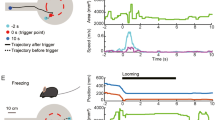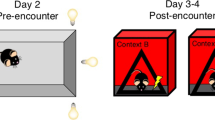Abstract
Rodents commonly approach sources of threat in a characteristic posture of stretched approach. There is considerable support for the view that the function of stretched-approach sequences is the acquisition of information about potential sources of danger. To determine whether monkeys, like rodents, engage in defensive information gathering, we recorded the behavior of three Old World monkeys (Cercopithecus species) after each had been exposed to threat in a seminatural environment. Each monkey displayed an intense startle and flight reaction when a jack-in-the-box that it was inspecting was triggered. Nevertheless, within seconds (M = 8 s), each monkey returned to the jack-in-the-box and spent much of the 20-min test session inspecting it (M = 905 s) while largely ignoring the stuffed-bear control object (M = 203 s). These results, in combination with previous studies of stretched-approach behavior in rodents, suggest that information gathering is an important defensive strategy in a variety of mammalian species. In the past two decades, theories of animal behavior have started to portray animals as users of information rather than as S-R automatons. Recent ethoexperimental studies of animal defense indicate that animals are more than passive receivers of information. Animals exposed to a threatening object purposefully approach the object to collect information about it.
Similar content being viewed by others
References
BLANCHARD, R. J., BLANCHARD, D. C., & HORI K. (1989). An ethoexperimental approach to the study of defense. In R. J. Blanchard, P. F. Brain, D. C. Blanchard, & S. Parmigiani (Eds.), Ethoexperimental approaches to the study of behavior (pp. 114–136). Boston: Kluwer Academic Publishers.
COSS, R. G., & OWINGS, D. H. (1985). Restraints on ground squirrel antipredator behavior: Adjustments over multiple time scales. In T. D. Johnston & A. T. Pietrewicz (Eds.), Issues in the ecological study of learning (pp. 167–200). Hillsdale, NJ: Erlbaum.
GRANT, E. C., & MACKINTOSH, J. H. (1963). A comparison of the social postures of some common laboratory rodents. Behaviour; 21, 246–259.
HUDSON, B. B. (1950). One-trial learning in the domestic rat. Genetic Psychology Monographs, 41, 99–145.
PINEL, J. P. J., HOYER, E., & TERLECKI, L. J. (1980). Defensive burying and approach-avoidance behavior in the rat. Bulletin of the Psychonomic Society 16, 349–352.
PINEL, J. P. J., MANA, M., & WILKIE, D. M. (1986). Postshock learning and conditioned defensive burying. Animal Learning and Behavior, 14, 301–304.
PINEL, J. P. J., MANA, M. J., & WARD, J. A. (1989). Stretched-approach sequences directed at a localized shock source by Rattus norvegicus. Journal of Comparative Psychology 103, 140–148.
PINEL, J. P.J., & TREIT, D. (1983). Conditioned defensive burying: A biological and cognitive approach to avoidance learning. In R. L. Mellgren (Ed.), Animal cognition and behavior (pp. 285–318). Amsterdam: North-Holland.
PINEL, J. P. J., & WILKIE, D. M. (1983). Conditioned defensive burying: A biological and cognitive approach to avoidance learning. In R. L. Mellgren (Ed.), Animal cognition and behavior (pp. 285–318). Amsterdam, Holland: North Holland Publishing Company.
RENNER, M. J. (1990). Neglected aspects of exploratory and investigatory behavior. Psychobiology, 18, 16–22.
SILVERMAN, A. P. (1965). Ethological and statistical analysis of drug effects on the social behavior of laboratory rats. British Journal of Pharmocology, 24, 579–580.
TERLECKI, L. J., PINEL, J. P. J., & TREU, D. (1979). Conditioned and unconditioned defensive burying in the rat. Learning and Motivation, 10, 337–350.
TREIT, D. (1991). A comparison of the effects of septal lesions and anxiolytic drugs on defensive behavior in rats. The Psychological Record, 41, 217–231.
VAN DER POEL, A. M. (1979). A note on “stretched attention,” a behavioral element indicative of an approach avoidance conflict in the rat. Animal Behavior, 27, 446–450.
WILLIAMS, J. (1991). Conditioned defensive responses and hypoalgesia in rats exposed to defeat and alpha-colony odors. The Psychological Record, 41, 271–297.
Author information
Authors and Affiliations
Corresponding author
Additional information
Portions of these results were reported at the annual Conference on Animal Learning in Ottawa, Ontario, May 1990, and the IX Biennial World meeting of the International Society for Research on Aggression in Banff, Alberta, June 1990.
We thank Mike Macintosh, Director, Stanley Park Zoo, Vancouver BC for his support and encouragement throughout this project. Thanks also to John W. Turtle for his technical assistance. This research was supported by a Natural Sciences and Engineering Research Council of Canada (NSERC) Postdoctoral Fellowship to Suzanne E. MacDonald, and a NSERC Operating Grant to John P. J. Pinel.
Rights and permissions
About this article
Cite this article
MacDonald, S.E., Pinel, J.P.J. Information Gathering: A Component of the Defensive Behavior of Rats and Old-World Monkeys. Psychol Rec 41, 207–215 (1991). https://doi.org/10.1007/BF03395106
Published:
Issue Date:
DOI: https://doi.org/10.1007/BF03395106




